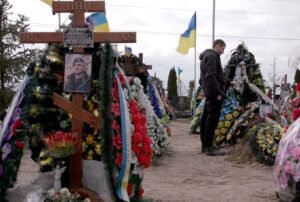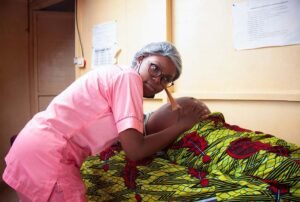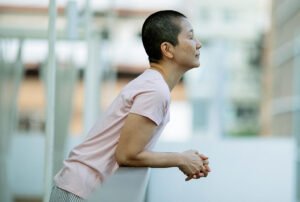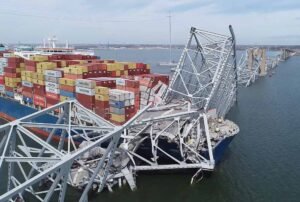Iris Crawford: So, break it down for me and for folks who will be watching this. What is climate psychology?
Rebecca Weston: Climate psychology belongs in a long tradition of what I think of as “witnessing professionals.” Robert Jay Lifton, a psychiatrist, has spoken out and frequently about the Vietnam War, has spoken out about nuclear weapons, and has also written a book [The Climate Swerve: Reflections on Mind, Hope, and Survival] about climate. He talks a lot about what is a witnessing professional. A witnessing professional is one who quite literally bears witness to the suffering that the world brings on people—the oppressive systems, the oppressive institutions—and how that impacts us in our internal and external worlds, and how professionals both historically have been on the side of resistance to some of those institutions, but also historically have sometimes been on the side of enabling those institutions. Institutions of oppression, institutions of normalization, institutions of repression, things like that. And climate psychology belongs, in my view, very firmly in the camp of a witnessing [profession] that [has] as one of its obligations to witness the harm being caused by any number of institutions and systems that are so interwoven with the climate crisis but can be summarized by the climate crisis.
Within that, there’s a number of different ways that I think about climate psychology as being a witnessing profession, and the first one is that we actually quite literally bear witness to the mental health impacts of extreme climate change and extreme weather events, ranging from the mental health impacts of drought, the mental health impacts of fire, the mental health impacts of flooding and hurricanes, and all of the sequelae of that. The homelessness that happens, the lack of shelter, the lack of livelihood, the lack of security. And then the differential impacts: how that affects women more if they’re in shelters and there’s an increase in violence, and the mental health impacts of that. So there’s all sorts of immediate, very specific impacts of extreme weather events all over the globe, and then how those play out in intersectional ways on different populations with different histories and different geographies. That’s one big part of what climate psychology does.
“A witnessing professional is one who quite literally bears witness to the suffering that the world brings on people—the oppressive systems, the oppressive institutions—and how that impacts us in our internal and external worlds.”
There’s another part of it, though, that also tries to explain and understand and address the ways in which ordinary people living their daily lives are impacted by extreme climate and climate distress—climate anxiety. How is it that we can understand why it looks like there’s business as usual? How do we understand how it is that we can be living in a planetary crisis and go on about our daily lives? That politicians are going on about their daily lives, how do we emotionally and psychologically grapple with the reality that there is something so profoundly terrifying happening, and yet, so many of us walk around during the day acting as if it’s not? I do not think of that in behavioral terms. I think about that in terms of fear, overwhelm, disavowal, afraid to acknowledge it, afraid because we don’t know how to address it, feelings of guilt, feelings of shame. So all of the emotional aspects that go into why it looks like there’s apathy when in fact, there’s tremendous amounts of care. But it’s hard to tap [into] because people don’t quite know what to do, especially thanks to the fossil fuel industry about the ideas that they generate.
And the third thing that climate psychology does, in my view, is it tries to understand the dangers if we don’t address this psychologically—if we don’t address people’s anxieties and fears and overwhelm. It’s not rocket science to see the rise in authoritarianism. And the rise in anti-immigrant hysteria and the rise in fascist movements, I think, are both directly and indirectly related to the deep sense of ill-at-ease, the deep sense of insecurity, and the territorial and tribal attempts to protect what one has, at the expense of other people, I think, is only growing. The murders in Buffalo [last year, of 10 people in a grocery store by a racist gunman] had a very clear ecofascist throughline, and I believe that’s only going to get worse if we don’t figure out a way to address the mental health as well as the policy aspects of climate change.
IC: Defining it as witnessing professional is really interesting because I think of journalists as griots and then as record keepers. Not just recording these issues but also seeing it and experiencing it in an empathetic way as well.
RW: I would add to the idea of witnessing—witnessing is also to attest, to speak out. It’s not just a quiet process. It’s not just a being with and experiencing process; it’s also proclaiming and naming. And I think one of the ways in which climate psychology is different from how other people experience psychology is that it needs to be an active voice on the side of human survival, on the side of compassionate and sustainable and socially just ways of addressing the crisis.
IC: Tell me about the Alliance’s beginnings. When was the need for it realized?
RW: There are two organizations. The Climate Psychology Alliance of the UK was the founding organization. It was really quite prescient. They very much understood that behavioral understanding of the crisis was not going to be particularly effective. How can we get people to change their consumption habits? How can we get people to change their transportation habits? They understood that there were deeper issues that were interfering with people’s ability to emotionally process what was happening in the world. And so it started in a psychoanalytic, depth psychology orientation. And what basically happened is that there were people who were doing a lot of really very important writing in the UK and wanted to connect with people in the United States who were also doing very similar writing in the US context. Elizabeth Allured comes to mind, Anthony Wilson in Canada comes to mind, and there’s others. That was about five years ago.
But it truly was, in terms of it becoming a much larger organization, since or within the pandemic. There has been a kind of tidal wave shift, to use an apt metaphor, in the volume and the intensity and the reach of what CPA North America is trying to do. And we didn’t quite expect it to go that fast. I remember when the term “climate anxiety” started making itself known. And there’s a lot of things to say about that term, but nevertheless, it popularized something so quickly that our membership grew very fast, our need to do programming increased very fast, and it kind of tumbled into more work, which we’re actually still trying to catch up on and trying to understand what is our place in trying not to duplicate efforts out there and to really reach a need?
“We’re a society that does not think about mental health in conjunction with institutional and systemic issues very well; it tends to become very individualized and very relational. So there’s real problems in the mental health system in the United States in terms of how it frames issues, and [who] gets care, and all of that.”
IC: Have you seen an uptick in demand for the Alliance’s services since the pandemic?
RW: At the individual level, we are still a society that does not do community mental healthcare well. We’re a society that has profoundly segregated and poor access to mental healthcare. We’re a society that does not think about mental health in conjunction with institutional and systemic issues very well; it tends to become very individualized and very relational. So there are real problems in the mental health system in the United States in terms of how it frames issues, and [who] gets care and all of that.
With that, though, there still is a centrality of work at the individual level. As we’ve gotten bigger, more clinicians are hearing of us and are realizing that they, too, want to be part of the climate solution. And also, as climate anxiety gets in the news, we are getting a lot more referrals. And again, I don’t think individual referrals are necessarily the measure of anxiety or distress out there, nor the way to address it necessarily, but that is one manifestation: that there are more and more people coming to individual therapy, naming the climate crisis as a big part of what they’re dealing with. Somebody asked the other day, who’s the typical climate client? And there really is no typical climate client. They are young people wondering about whether or not to have children. In fact, one couple is breaking up because they have decided one wants to and the other doesn’t because of the climate crisis. I have another person who quit her job being a midwife because she felt like she did not want to bring children into this world. I have another woman who was undocumented and was trying to get across the border and was panicked both because of anti-immigrant hysteria and the climate crisis and felt utterly dropped and ignored by government institutions, if not stigmatized and blamed….It goes on and on.
And then even more, as the fires and the smoke increased here on the East Coast, the ambient anxiety that was not necessarily named as climate-related [before] is starting to be named as climate-related, even by clients who are not coming for that purpose. And they’re wondering [about] their sense of malaise, they’re wondering about their sense of despair, they’re wondering about why are they feeling a sense of dread or anxiety that they can’t name? And of course, there’s lots of reasons for that, including anti-democracy….I mean, we have, unfortunately, way too many interrelated reasons to be feeling that way. But in particular, climate has been coming up a lot more, certainly on the East Coast….I can’t imagine it not being true down in the South and the Southwest, and certainly in California.
The other way it’s coming up is that organizations, particularly climate-focused organizations, whether they’re activist oriented or otherwise, are beginning to be very aware of the stress on their own staff and their own team. And activist organizations are wondering what the strategy is to address this as they feel more and more like the issue is on their shoulders. And so we are getting much more outreach to provide care, an analytic frame, a way to understand what’s happening in the world. And that’s happening through a lot of different organizations, including news organizations.
How do we then understand this in a way that people don’t feel utterly hopeless? Realistic, but not utterly hopeless, and at the same time, find ways to regenerate?
Sign up for our free newsletters
Subscribe to NPQ's newsletters to have our top stories delivered directly to your inbox.
By signing up, you agree to our privacy policy and terms of use, and to receive messages from NPQ and our partners.
IC: As the co-president of the Alliance, how are you handling the responsibility of being the person or the organization that folks are now turning to, and how are you taking care of yourself?
RW: It’s an honor, actually. I have always been a social and political activist, and always moved around large institutional and systemic issues. That’s been part of how I identify with my place in the world is to address those issues….I really believe in the interpersonal, and I really believe in the relational, and I really struggled at different times to go from that larger macro place to the place of intimacy and individual relationships and individual work because I think that they’re really dialectically related. I don’t think that there’s a huge, bright separation. So, to be honest, the really good thing about being in this role is that I finally get to bring those parts of myself together in a way that feels far more authentic and far more responsive to the way I see the world. That feels incredibly lucky. And it’s also really sustaining. It’s very different from other kinds of activism I’ve done, whether it’s strikes or arrests, those kinds of things, all of which I’m very familiar with and have been part of. But it feels really, really vital, nevertheless, and I know that people use this phrase all the time, turning anxiety into action, but it’s actually, in this case, really, really true….I could not imagine living at this moment in the world and not feel as though I was doing something real, something meaningful. Will I ever see its outcome? No. But I couldn’t imagine living with myself or my children or my community or the world if I weren’t doing something about that. It’s too much part of who I identify as. And so this also addresses my own anxiety, my own distress. And that’s really real.
That said, we are right now an all-volunteer organization. We are in the middle of some growing fundraising efforts, in part around the trauma-informed climate journalism project, which I’d be happy to talk about, but it’s not sustainable at a voluntary level. It’s absorbing huge amounts of my time and the time of a lot of other people, [including] my co-president, Barbara Easterlin. We are definitely needing resources, we’re definitely writing grants, we’re definitely developing a development program, all of those kinds of things.
I was literally just talking about self-care with somebody this morning who has been devoted to climate adaptation work and climate resiliency work as a scientist nearly all of her adult life. And she was asking, How do we take care of ourselves? I find the work of Sarah Jaquette Ray really quite helpful and have taken it very much to heart that we need to be motivated by love. We need to be motivated by what we care most about on the planet, and we need to be able to access the places where we feel spacious and open. And for me, that’s taking long walks. I do a lot of pottery; I do a lot of photography. I think it’s essential that I tap into the parts of myself that feel grounded in what I love most in the world. I don’t think that there’s any one way to do that, but I think it’s absolutely essential. And I am building in more and more time for that as I get more intensely involved. That’s a key piece of that work, how to feel like that’s not only necessary but vital for ourselves, for other people in building the movement and staying in it for the long haul, sticking with a problem for the long haul.
IC: Tell me about the trauma-informed climate journalism project. What’s happening?
RW: Well, a lot is happening. And you were sort of witness to the beginning of it, and I really do credit a couple of people, especially Amy Westervelt….We have been hobbling around with this idea and recognition that the field of climate communication is essential but tends to be very information heavy, and statistics heavy. I think that there’s a general understanding that people don’t respond well to doomsday headlines, but there’s not [a lot] of models about how to do something different[ly], particularly in a clickbait-heavy, profit-driven journalism world. And we began thinking about it first as a way to try to introduce psychological ideas and understandings of trauma in the reporting world. How are the articles affecting people and getting active in the world?
My interest [is] in understanding the doom that people are coming in with in my office, [and] understanding how we can move people…into creative action. Those questions really animated it and got me thinking quite a bit about climate journalism, generally. And then Liliana was saying, “What is it like to be a journalist whose articles, for all sorts of reasons, are expected to conform to these kinds of narratives, or they don’t give enough time to really delve into solutions in an effective way?” It got us to thinking about the role of what the newsroom [is like]. How are journalists experiencing having to report these things but then living in their lives around a lot of people who don’t read the work because of news avoidance, or family members who don’t want to hear it? So they’re becoming sort of isolated Cassandras in their own world, and that’s a terribly isolating place to be.
And our work with Solutions Journalism Network and Uproot is deepening. We are imagining actually creating a genuine project in a collaborative way that could include a survey of journalists about what they need. We’re starting to give presentations with SJN about trauma-informed journalism, about how to represent communities in a way that doesn’t flatten their experience of trauma. How do we really deepen and embody the people who are continuing to live in so-called disaster zones? Do we represent them as just completely flattened and not taking steps to address their own lives in ways that feel very deeply rooted in their own histories? How do we do that in a way that makes people feel like they’re alive, and not just these inert victims of circumstance?
So all of that is starting to come forward. With SJN, with Uproot, it’s all at the beginning stages. But it’s, to me, tremendously exciting, and there’s beginning to be buy-in that this needs to happen, at least within the SJN world, and how that needs to be woven into our understanding of solutions about connecting on the ground, addressing social and emotional aspects, connecting to not only layered trauma but in a much more meaningful sense, layered survival and thriving.
IC: I’m excited to see how it all continues to take shape. How are you telling your clients to prioritize rest and wellness? How crucial do you think rest and wellness really are at this point in time?
RW: I think I know the answer you’re wanting me to give, but I think I’m going to give more than one. I think for some clients, the urgency is to give them room to act on the things that they see going around them. There’s a lot of barriers, internal barriers and the language of professionalism barriers that prevent people from accessing the emotions that they’re feeling about climate. And so part of it is actually urging them to feel those feelings. They’re not irrational, they are vital to understanding that we need, in fact, to be active in the world. And so part of it is to provide enough space and support to validate and amplify feelings that are already there. So that doesn’t automatically lead to rest. In some ways, it might lead to, “How do I get involved? How do I get out?”
For others, namely, activists or people who go the other way—some people kind of block it out and kind of numb themselves because they don’t have ways to access or act on those feelings in their worlds for all sorts of reasons. So the goal is actually to bring it forward. For others who are so hypervigilant and somewhat tortured in their day-to-day life about never doing enough, never feeling like they can relax, always feeling like they need to contribute just a little bit more to the solution, for those people, absolutely, the emphasis is how to recognize when you need to access other parts of yourself, what it means to relax, to take time off, to enjoy buying something that you know is going to have a carbon footprint…and in some ways, getting out of the individualist model of the movement.
And that’s where Sarah Jaquette Ray’s work in her book is really, really wonderful about giving us ways to think about success and joy and love in a slightly larger scope, with the economy and in a society that is so rapid and so quick and so results oriented, understandably, around climate. But it also makes it very difficult to recognize that there’s value in something other than what we can see immediately. We’re contributing to a larger cultural shift as much as anything. I also then think about ways in which we think about activism to emphasize relationship, to emphasize connection to people, not individualist consumption-oriented work or anything else. And I think that when you flip it a little bit into what does count as productive action, it can also lead you to collective ways of being active, which can then settle some of that hyperawareness of the system that is being activated all the time.
IC: One thing that you had said, the beginning of your answer was interesting in terms of looking at how we redefine activism. I think about journalism, especially with climate journalism, I started writing because just having a lot of stories from folks in the movement and the work that they were doing was naturally the stories that I wanted to tell and ended up writing. I often think about movement journalism as a concept that’s central to my work, and a lot of folks that I really appreciate are also journalists and editors.
RW: Can I ask you a question? Can you tell me a little bit about what you think is movement journalism? I would love to know a little bit more about what that looks like or includes.
IC: It started in the South. And an organization that does a lot of this work is called Press On. They’re a liberatory collective in the South focused on movement journalism. The Craig Newmark School focuses on that, too, in their Engagement Journalism program. It’s centering the most impacted communities and figuring out how your reporting can serve them. So instead of reporting on them, report with and for them. Of course, you can’t do that all the time. Sometimes you actually just need to file a story and get it published. But I think movement journalism has always been the kind of work that I do and what I hope to continue to do in my time as a journalist, in whatever capacity that may be.
RW: I’m really moved and excited to hear about the way you’re talking about movement journalism. And one of the things that’s coming to mind in that context is that in a number of places where I’ve started speaking with journalists in larger group contexts, whether it’s at NPR or major climate newspapers, is the feeling that if they use or rely on their emotions or have emotions as they’re reporting, that that is somehow illegitimate, or that they’re being too activist. And it bumps up against—beginning to be antiquated but still pretty heavily pronounced—notions of professionalism in a very macho big newsroom culture. And that’s come up a lot: what are the boundaries? What are the boundaries between being very engaged and very connected to issues that matter to all of us as people living in systems of racism and inequity and climate? How are we expected to report on those things without having an emotional reaction, without being part of wanting a solution?
And I think that that challenge is, again, the boundaries between journalism and living in the world that happens constantly in my work as a clinician. And I think it’s actually part of our witnessing obligation, actually, to bring those things into the space, to name them, to address them, to define professionalism in a way that allows those to be part of what it means to be a good journalist, what it means to be a good clinician. And I’m not saying pour ourselves all over our story, but I am saying that use the feelings, use the reactions, use the experience as a way to connect to the people we’re talking to and as a way of showing that we actually have skin in the game, quite literally, on these issues. And again, I know that that attacks some sacred cows, but…in the concept of movement work, how to do that ethically and with an appropriate sense of boundary and connection, I think, is very much part of what this work should include.
IC: I think that’s one of the privileges in my journalism journey thus far being able to do that. Two publications that I often think about that do this quite awesomely is Scalawag magazine—they’re based in the South…and Southerly magazine. They’re not operating right now. They actually closed up shop this year….It was really sad to see that. But I think their editor-in-chief has something else coming. But Scalawag and Southerly magazine are two publications that really embody that movement journalism framing to me.
RW: Thank you for that. And again, you’re raising [that] the overlap is so important, because another piece—and I think this is also beginning to break down—is talking about what is the relationship, or what is the responsibility of journalists to take care of the audience they are reaching and the people about whom they’re reporting? And when we frame things as just the facts, the hard-hitting facts, that’s framing things in extremely limited ways. Facts are a lot of things. Facts include emotional reactions, facts include social justice, facts include impact. And I would especially say in this context around climate journalism, we have to be aware of how we report, how that impacts people’s sense of capacity to take action and capacity to be part of the larger movement. If people feel like it’s over and done, or if they feel like this systemic process is so massive that there’s no point of intervention, then what’s the point of the journalism in the first place? So again, I know that that raises questions about traditional journalism, but clearly not for you. I mean, obviously, you’ve given your life to thinking about those questions. And I admire that, obviously. I admire it tremendously.












